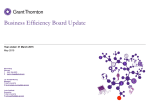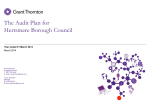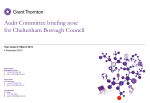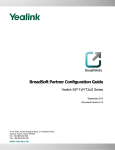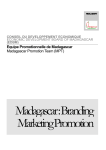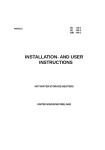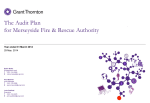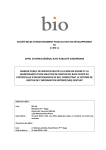Download The Audit Plan – template user guide
Transcript
Business Efficiency Board Update Year ended 31 March 2015 February 2015 Mark Heap Director T 0161 234 6375 E [email protected] Liz Temple-Murray Manager T 0161 214 6370 E [email protected] John Padfield Executive T 0161 214 6378 E [email protected] © 2015 Grant Thornton UK LLP The contents of this report relate only to the matters which have come to our attention, which we believe need to be reported to you as part of our audit process. It is not a comprehensive record of all the relevant matters, which may be subject to change, and in particular we cannot be held responsible to you for reporting all of the risks which may affect your business or any weaknesses in your internal controls. This report has been prepared solely for your benefit and should not be quoted in whole or in part without our prior written consent. We do not accept any responsibility for any loss occasioned to any third party acting, or refraining from acting on the basis of the content of this report, as this report was not prepared for, nor intended for, any other purpose. . Contents Section Page Introduction 4 Progress at February 2015 5 Emerging issues and developments 8 © 2015 Grant Thornton UK LLP 3 Introduction This paper provides the Business Efficiency Board with a report on progress in delivering our responsibilities as your external auditors. The paper also includes a summary of emerging national issues and developments that may be relevant to you. Members of the Business Efficiency Board can find further useful material on our website www.grant-thornton.co.uk, where we have a section dedicated to our work in the public sector (http://www.grant-thornton.co.uk/en/Services/Public-Sector/). Here you can download copies of our publications including: • Working in tandem, local government governance review 2014, our third annual review, assessing local authority governance, highlighting areas for improvement and posing questions to help assess the strength of current arrangements • 2016 tipping point? Challenging the current, summary findings from our third year of financial health checks of English local authorities • Local Government Pension Schemes Governance Review, a review of current practice, best case examples and useful questions to assess governance strengths • Responding to the challenge – Alternative Delivery Models in Local Government If you would like further information on any items in this briefing, or would like to register with Grant Thornton to receive regular email updates on issues that are of interest to you, please contact either your Engagement Lead or Engagement Manager. Mark Heap, Engagement Lead T 0161 234 6375 M 07880 456 204 E [email protected] Liz Temple-Murray, Engagement Manager M 07880 456 171 E [email protected] © 2015 Grant Thornton UK LLP 4 Progress at February 2015 Audit work 2014-15 Accounts Audit Plan We are required to issue a detailed accounts audit plan to the Council setting out our proposed approach in order to give an opinion on the Council's 2014-15 financial statements. Progress against plan on track Opinion and VfM conclusion all planned to be met Outputs delivered Fee letter and Progress Reports delivered to plan Planned date Complete? Comments March 2015 In progress We sent the 'Planned fee letter for 2014/15' to the Council on 24 April 2014 and presented it to the Board on 11 June 2014. This included notification of the scale fee of £139,322 set by the Audit Commission, the scope of the audit and an outline audit timetable. The Audit Commission has now confirmed an updated scale fee of £140,392 to take into account a supplementary fee for audit work on business rates. The Audit Plan will be presented to the next meeting of the Business Efficiency Board. Interim accounts audit Our interim fieldwork visit including: • updated review of the Council control environment • updated understanding of financial systems • review of Internal Audit reports on core financial systems • early work on emerging accounting issues • early substantive testing • proposed Value for Money conclusion. © 2015 Grant Thornton UK LLP December 2014 to March 2015 In progress We will build on our knowledge of the Council following the audit last year. We are currently completing our interim work and issues arising will be set out in the Audit Plan presented to the next meeting of the Business Efficiency Board. 5 Progress at February 2015 Audit and certification work 2014-15 final accounts audit Including: Planned date Complete? Comments June to Not yet September 2015 started • audit of the 2014-15 financial statements and Whole of Government Accounts (WGA) • proposed opinion on the Council's accounts and WGA • proposed Value for Money conclusion. Value for Money (VfM) conclusion The scope of our work to inform the 2014/15 VfM conclusion comprises the two criteria specified by the Audit Commission: • The organisation has proper arrangements in place for securing financial resilience. The focus will be on whether the Council has robust systems and processes to manage effectively financial risks and opportunities, and to secure a stable financial position that enables it to continue to operate for the foreseeable future. • The organisation has proper arrangements for challenging how it secures economy, efficiency and effectiveness. The focus will be on how the Council is prioritising its resources within tighter budgets, for example by achieving cost reductions and by improving efficiency and productivity. Other areas of work – certification work under the Audit Commission Regime • 2013/14 - Housing Benefit (HB); Two transport (TRA) - Mersey Gateway and Silver Jubilee Bridge January to In progress September 2015 The detailed guidance from the Audit Commission has now been published on its website for the benefit of auditors and audited bodies. This includes the key areas for consideration that will be reviewed under both the criteria. We are starting to carry out an initial risk assessment to determine our approach and report this in our audit plan HB 28 November 2014 2013/14 complete TRA 31 December 2014 The letter reporting the outcome of our certification work 2013/14 is being presented to the February 2015 BEB meeting • The Housing Benefit claim - certified with no qualification letter and a small amendment. • The Silver Jubilee Bridge and Mersey Gateway Bridge transport claims - certified with no amendment or qualification letters. • Grant Certification 2014/15 – Housing Benefit; transport claims November and December 2015 respectively © 2015 Grant Thornton UK LLP 2014/15 not yet started 6 Progress at February 2015 Non-audit services work Planned date Complete? Comments PEN complete • We completed the Teachers' Pensions return by the deadline; there were no amendments and nothing to report by exception. The final fee was the same as the agreed fee of £4,200. • The DCLG has recently informed the Council of new deadlines for RGF claims - 15 June 2015 for submission by the Council and 30 June for the auditor's report. Other activity undertaken * – claims and returns You asked us to provide a report on a number of claims that do not fall under the Audit Commission regime: • independent report on Teachers' Pensions return (PEN); agreed fee £4,200 • independent report on Regional Growth Fund claim (RGF); agreed fee £3,110 PEN 28 November 2014. Other activity undertaken* – tax Other service lines within Grant Thornton UK LLP have undertaken Tax (Employee Solutions) work for the Council: • Tax; agreed fee £8,750 Other activity undertaken* – VAT Other service lines within Grant Thornton UK LLP have undertaken VAT advice and Tax (Employee Solutions) work for the Council: • VAT; agreed fee £25,800 - £27,800 By March 2015 Substantially complete Tax work comprises: Construction Industry Scheme training workshop; review of the tax treatment of the Council's salary sacrifice scheme; and advice relating to the Mersey Gateway Crossings project. By March 2015 Substantially complete VAT work includes advice and queries on: the development of Norton Priory; the pooled budget; option to tax; Runcorn Hill Park Café; the treatment of dilapidations; s106; GPark Widnes; Assist Education. RGF Feb 2015 (revised date June 2015) RGF rescheduled Note re: Other activity undertaken* • We are required to disclose in writing to the Council the auditor independence assessment and summary of non-audit services and related safeguards; and that we are independent and the objectivity of the audit partner and audit staff are not impaired. We confirm that we are satisfied that our independence as external auditor to the Council will not be impaired by any of this additional work. The tax and VAT work will be led and undertaken by a team separate from the audit team; our work does not involve making decisions on management's behalf. The certification work is in line with certification work completed under the Audit Commission framework; the scope does not include making decisions on behalf of management or recommending or suggesting a particular course of action for management to follow. • We are required to seek specific approval from the Audit Commission for Grant Thornton to undertake additional work over a threshold of 20% of the audit fee. We can confirm that the Audit Commission has noted our arrangements to ensure independence and approved the additional fee work noted above. © 2015 Grant Thornton UK LLP 7 Grant Thornton training and publications Grant Thornton Accounts workshops for local government: Grant Thornton is running workshops in partnership with CIPFA for preparers of accounts at Local government bodies. The workshops are designed and delivered by CIPFA colleagues and our highly experienced public sector assurance team and will be delivered through a mix of presentations and group exercises to maximise networking opportunities and shared learning. They will help officers prepare for the financial statements by highlighting potential risk areas and giving the opportunity for discussion and questions. Amongst the areas covered are: • the revised accounting treatment for group accounts and joint arrangements; • accounting for schools; • year-two accounting for business rates retention; and • material cross-cutting issues and disclosure requirements.. The local workshops are: 27 Feb 2015 Preston 3 and 6 March 2015 Manchester Forthcoming publications: Grant Thornton is the appointed external auditor to around 40% of local government bodies in England, giving us an excellent insight into the key issues facing the sector and the solutions being adopted across the country. From research, meeting with key people, carrying out presentations and workshops, and attending audit committees, we find that many of the key issues raised and risks faced are common to many authorities. We have a programme of publications for up-to-date insight and analysis from our technical, sector and service teams – such as our December 2014 report 'Rising to the Challenge' on financial health at English local authorities. Planned publications relevant to local authorities include: • Audit Committee Effectiveness (survey) • Welfare Reform (second report) • Health and Wellbeing Guide (Place Analytics) • Alternative Delivery Models (2nd report) • Where Growth Happens (2nd report) © 2015 Grant Thornton UK LLP 8 Rising to the challenge – financial health of local government Grant Thornton Our national report, Rising to the Challenge, the Evolution of Local Government, was published in December and is available at: http://www.grant-thornton.co.uk/en/Publications/2014/Rising-to-the-challenge---The-evolution-of-local-government/ This is the fourth in our series of annual reports on the financial health of local government. Like previous reports, it covers key indicators of financial performance, strategic financial planning, financial governance and financial control. It also includes case studies of best practice and a comparison to the NHS. This year it has been extended to use benchmarking information on savings plans and budget performance. The overall message is a positive one. What stands out is how well local authorities have navigated the first period of austerity in the face of ever increasing funding, demographic and other challenges. Many authorities are forecasting financial resilience confidently in their medium term financial strategy. This reflects an evolution in financial management that would have been difficult to envisage in 2010. However, there remains much to be achieved if the sector is to become sustainable in the long term, and authorities should consider if their: • medium- to long-term strategy redefines the role of the authority creatively • operational environment will adapt, working in partnership with other authorities and local organisations • strategy looks beyond the traditional two- to three-year resource planning horizon • organisational culture is aligned to where the authority needs to be in the medium to long term • senior leadership teams – both officers and members – have the necessary skills and capacity to ensure delivery against the mediumterm challenges • corporate governance arrangements ensure effective oversight and scrutiny of the organisation as it adapts to the challenges it faces. The importance of these actions will be magnified if local government devolves further, particularly in relation to fiscal devolution. The new-found confidence of local government in responding to the medium-term challenges will be tested significantly by the second phase of austerity. Hard copies of our report are available from your Engagement Lead or Audit Manager. © 2015 Grant Thornton UK LLP 9 All Aboard? – Local Government Governance Review 2015 Grant Thornton Our national report, Local Government Governance Review 2015: All Aboard, was published in February and is available at: http://www.grantthornton.co.uk/en/Publications/2015 The challenges faced by local authorities continue to intensify. The task of maintaining good and effective governance is becoming ever more complex, and at the same time increasingly important. This report aims to assist the managers and elected members of councils, fire & rescue authorities (FRAs) and police bodies to assess the strength of their governance arrangements and to prepare for the challenges ahead. We have focused on three particular aspects: • governance of the organisation: ensuring internal governance arrangements are robust, with risks properly managed while effective scrutiny holds the executive to account • governance in working with others: implementing appropriate governance arrangements for alternative service delivery models and new crosssector responsibilities such as public health • governance of stakeholder relationships: engaging with stakeholders to inform and assure them about service performance, financial affairs and governance arrangements. The findings are based on comprehensive research by auditors and a wide-ranging survey of council / FRA /police senior officers and members. We report that: • 90% of our survey feel their organisations encourage well-managed risk taking and innovation, but: • 46% consider that backbench members have no real influence over council decisions • 43% think scrutiny committees are not effective at challenging the way authorities do things • 87% of respondents say their organisations are now using or considering alternative delivery models but only 45% feel that scrutiny of service quality is sufficiently challenging • 49% say the transition to police and crime commissioners has not had a positive impact on local partnership working arrangements • 42% see no difference in local healthcare governance as a result of councils’ new public health role • The annual accounts and annual governance statement continue to expand in length, making them even more challenging for the public to read and understand • Only 30% of cabinet positions in local authorities are held by women, while over half our survey say members do not adequately reflect the demographic profile of the local population. Alongside the research findings, the report highlights examples of good practice and also poses a number of questions for management and Members, to help them assess the strength of their current governance arrangements. Hard copies of our report are available from your Engagement Lead or Audit Manager. © 2015 Grant Thornton UK LLP 10 Accounting for schools Accounting and audit issues Accounting for schools The debate about the recognition of school land and buildings on local authority balance sheets (which most commentators had thought settled) has been reignited. Grant Thornton is taking a leading role in trying to resolve this unexpected development. In March, CIPFA/LASAAC Code concluded that under IFRS 10, maintained schools (but not free schools or academies) meet the definition of entities that need to be consolidated in group accounts. However, rather than requiring local authorities to prepare group accounts, the CIPFA/LASAAC Code requires local authorities to account for maintained schools within their single entity accounts. This includes school income and expenditure as well as assets and liabilities. The general expectation in the sector was that: • the vast majority of voluntary aided, voluntary controlled and foundation schools would be recognised on local authority balance sheets • a small number of school buildings that are provided at no charge by a religious body and where there was a realistic possibility that they could be taken back by their owners would be treated as assets of the religious body and so not recognised on the local authority balance sheet. However, at the CIPFA conference in November, CIPFA clarified that it considers that most voluntary aided and voluntary controlled school buildings would not be recognised on the balance sheet. This view has been set out in more detail in LAAP 101. This is because the religious bodies have a legal right to take back these assets. Nor does CIPFA consider the position for foundation school building to be clear cut and local judgement would need to be applied. We are discussing issues with CIPFA in particular: • how the treatment proposed by CIPFA complies with the Code • the significant practical implications for the sector • the potential for inconsistent accounting treatments depending on local judgement. We are working with the Audit Commission, CIPFA and the other audit firms suppliers to try to seek a practical way forward as soon as possible. We will continue to share the latest developments with officers. In the mean time we note your preparations for recognising school land and building including: • identifying those schools where school buildings are owned by third parties (such as church dioceses) and determining under what circumstances the buildings could be taken back by the third party • obtaining valuations for school land and buildings for each of the three balance sheet dates (1 April 2013, 31 March 2014, 31 March 2015) • obtaining sufficient information to enable the authority to restate its revaluation reserve and capital adjustment account. © 2015 Grant Thornton UK LLP 11 Group accounting standards Accounting and audit issues The CIPFA Code has adopted a new suite of standards for accounting for subsidiaries, associates and joint arrangements. These changes affect how local authorities account for services delivered through other entities and joint working with partners. The key changes for 2014/15 are to: • the definition of control over 'other entities'. The revised definition is set out in IFRS 10 and determines which entities are treated as subsidiaries • the accounting for joint arrangements. This now follows IFRS 11 and includes changes to the definition of joint ventures and how joint ventures are consolidated in group accounts • disclosures in relation to subsidiaries, joint arrangements, associates and unconsolidated entities as set out in IFRS 12. Changes to the definition of control over 'other entities' Control was previously defined in terms of power to govern the financial and operating policies of an entity. IFRS 10 sets out three elements for an investor to be considered as controlling an investee (all of which must be met): • the investor has the rights to direct the relevant activities of the investee (relevant activities being the ones that determine the return for the investors – the return could be in the form of a service rather than money) • the investor has exposure, or rights, to variable returns from its involvement with the investee • the investor has the ability to use its power over the investee to affect the amount of the investor’s returns. In the commercial sector, this is generally thought to have resulted in more entities being treated as subsidiaries. However, the change is in both directions: some subsidiaries have been redefined as associates. Local authorities with investments in 'other entities' will need to consider whether: • they control any entities using the new definition. Local authorities will need to pay particular attention to special purpose vehicles and any other entities where there was a close judgement call under the old IAS 27 • there is a need for a prior period adjustment. © 2015 Grant Thornton UK LLP 12 Group accounting standards (continued) Accounting and audit issues Changes to accounting for joint arrangements Joint arrangements are contractual arrangements between two or more parties where there is joint control. IFRS 11 makes three key changes from IAS 31: • there are now only two types of joint arrangements: joint operations and joint ventures • In a joint operation the investing parties have rights and obligations in relation to the arrangement’s assets and liabilities, whereas in a joint venture the parties have rights to the arrangement’s net assets. IFRS 11 bases its definition of joint ventures on the substance of the arrangement rather than legal status. It is for the entity to assess whether a joint arrangement is a joint operation or joint venture by considering its rights and obligations arising from the arrangement. To do this the entity needs to consider the structure and legal form of the arrangement, the terms agreed by the parities and any other relevant facts and circumstances. Appendix B to IFRS 11 provides further explanation and examples of joint operations and joint ventures. • local authorities are still required to consolidate joint ventures in their group accounts but must now do so using the equity (single line) method. The option for proportionate (line-by-line) consolidation has been removed. The key challenge for most local authorities will be determining whether their joint arrangements are joint ventures or joint operations. The difference should be clear from the contract but in some cases judgement may be required. Local authorities that have previously used the proportionate consolidation method will need to account for the move to equity accounting as a prior period adjustment. Disclosure of interests in other entities IFRS 12 makes consistent the requirements for disclosures in relation to subsidiaries, joint arrangements, associates and unconsolidated entities. It includes the need for transparency about the risks to which the reporting entity is exposed as a consequence of its investment in such arrangements. © 2015 Grant Thornton UK LLP 13 Earlier closure and audit of accounts Accounting and audit issues DCLG is consulting on proposals to bring forward the audit deadline for 2017/18 to the end of July 2018. Although July 2018 is almost 4 years away, both local authorities and their auditors will have to make real changes in how they work to ensure they are 'match-fit' to achieve this deadline. This will require leadership from members and senior management. Local government accountants and their auditors should start working on this now. Top tips for local authorities: • make preparation of the draft accounts and your audit a priority, investing appropriate resources to make it happen • make the year end as close to 'normal' as possible by carrying out key steps each and every month • discuss potential issues openly with auditors as they arise throughout the year • agree key milestones, deadlines and response times with your auditor • agree exactly what working papers are required. © 2015 Grant Thornton UK LLP 14 Financial sustainability of local government Local government guidance In November the National Audit Office published their report on the Financial Sustainability of Local Government. The report concludes that Local authorities have coped well with reductions in government funding, but some groups of authorities are showing clear signs of financial stress. The Department for Communities and Local Government has a limited understanding of authorities’ financial sustainability and the impacts of funding cuts on services, according to the National Audit Office. The Government reduced its funding to local authorities by an estimated 28% in real terms between 2010-11 and 2014-15. Further planned cuts will bring the total reduction to 37% by 2015-16, excluding the Better Care Fund and public health grant. Although there have been no financial failures in local authorities in this period, a survey of local auditors shows that authorities are showing signs of financial pressure. Over a quarter of single tier and county councils had to make unplanned reductions in service spend to deliver their 2013-14 budgets. Auditors are increasingly concerned about local authorities’ capacity to make further savings, with 52% of single tier and county councils not being well-placed to deliver their medium-term financial plans. There are significant differences in the scale of funding reductions faced by different authorities. Authorities that depend most on government grant are the ones most affected by funding reductions and reforms. This was an outcome of policy decisions to tackle the fiscal deficit by reducing public spending, and for local authority funding to offer incentives for growth. Local authorities have tried to protect spending on social care services. Other service areas such as housing services and culture and leisure services have seen larger reductions. While local authorities have tried to make savings through efficiencies rather than by reducing services, there is some evidence of reduction in service levels. According to the NAO, however, the Department does not monitor in a coordinated way the impact of funding reductions on services, and relies on other departments and inspectorates to alert it to individual service failures. In consequence, the Department risks becoming aware of serious problems with the financial sustainability of local authorities only after they have occurred. The Department’s processes for assessing the capacity of authorities to absorb further funding reductions are also not sufficiently robust. © 2015 Grant Thornton UK LLP 15 Public Health England - supporting local authorities with their new responsibilities for public health Local government guidance The National Audit Office (NAO) has recently published a report that finds that Public Health England (PHE) has made a good start in supporting local authorities with their new responsibilities for public health. The NAO considers however that it is too early to tell whether PHE’s approach is achieving value for money. PHE provides advice to local authorities on public health and gives them a ring-fenced grant to carry out their new public health responsibilities – £2.7 billion in 2013/14. The agency has, however, encountered some problems with the accuracy of how local authorities record what has been spent on public health. Spending on different aspects of public health varies significantly between local authorities, reflecting the differing needs and circumstances of different areas. The NAO found, however, examples where spending decisions were not obviously aligned to local needs and priorities. The NAO found that PHE could do more to identify these examples and offer appropriate advice and support to local authorities. Public health funding increased by 5.5% in 2013/14, reflecting the importance the Department of Health places on this issue. Historic local decisions on public health funding by the NHS have left some local authorities receiving a significantly greater or lesser proportion of the funding than they would have been allocated based on need. The Department has not decided how long the ring-fence will remain in place. According to the NAO, PHE’s ability to influence and support public health outcomes will be put to the test in future, should the grant cease to be ring-fenced. to influence and support public health outcomes will be put to the test in future, should the grant cease to be ring-fenced. © 2015 Grant Thornton UK LLP 16 Local government financial reporting remains strong Local government guidance – Audit Commission Auditing the Accounts 2013/14 The Audit Commission published its report, Auditing the Accounts 2013/14: Local government bodies, on 11th December. Audited accounts are the principal means by which public bodies discharge their accountability for the stewardship of public money. Publishing timely audited accounts, with an unqualified audit opinion, reflects well on bodies' financial management arrangements and is a fundamental feature of good governance. Key messages: • The audit opinion was issued by 30 September at 99 per cent of councils, 90 per cent of fire and rescue authorities, 97 per cent of police bodies, all other local government bodies and 99 per cent of both parish councils and internal drainage boards. This is consistent with last year for most groups, but an improvement for councils and small bodies compared to 2012/13. Eight principal authorities were listed where the auditor was unable to issue an opinion by the 30th September deadline. • Overall, 506 out of 512 principal bodies met the statutory accounts publication requirements. • Sixteen principal bodies received an unqualified opinion by 31 July 2014 and published their audited accounts promptly. This compares to 13 bodies for 2012/13. Although, as only 21 principal bodies have managed to publish their audited accounts by 31 July since 2008/09, a move to bring the accounts publication date forward is likely to cause significant challenges for the majority of public bodies. • The RFO failed to sign and certify the accounts by 30 June 2014 at five principal bodies. • At the date of preparing this report, no principal bodies had received a qualified audit opinion on the 2013/14 accounts. • Auditors aimed to issue the assurance statement on the WGA return by 3 October 2014. They were able to do so at 95 per cent of principal bodies. This is a slight reduction from 2012/13, where auditors at 97 per cent of principal bodies were able to issue their assurance report by the specified submission date. • The timeliness of WGA reporting has improved since 2008/09 although there is scope for bodies to improve the quality of the information submitted to inform the WGA. • Of the 2013/14 conclusions on bodies’ arrangements to secure VFM issued by auditors at the date of preparing this report, only those for 14 councils and two police bodies were qualified. Auditors issued a ‘report on matters arising’ from their VFM work at one council and one other local government body. • Auditors exercised their public reporting powers and issued public interest reports at two principal bodies and five small bodies. © 2015 Grant Thornton UK LLP 17 Council tax and business rates income rises, despite £4.55 billion uncollected Local government guidance – Audit Commission Council tax and business rates collection The Audit Commission has published Council tax and business rates collection: an update (November 2014),using publicly available data from its Value for Money (VFM) Profiles Tool. The update to two previous briefings, examining English councils’ collection rates and costs of collecting council tax and business rates, reveals that £4.55 billion remained unpaid at the end of March 2014. The uncollected £4.55 billion is equivalent to the cost of building close to 300 secondary schools. The debt consisted of over £1.21 billion of outstanding council tax and business rate payments that councils were unable to collect for 2013/14 and £3.34 billion due to councils from previous years. Councils collected just over £46.05 billion of the nearly £47.26 billion due to be collected in 2013/14. Council tax collection rates for 2013/14 varied, both between types of council and among councils of the same type, from 91.7 per cent to 99.3 per cent. The council tax in-year collection rate for all types of council fell in 2013/14, except London boroughs, which remained unchanged, resulting in an overall national average fall of 0.4 per cent to 97 per cent compared to the previous year. This is only the second fall in the overall national in-year collection rate since council tax was introduced in 1993/94. Had the previous year’s collection rate been maintained, councils would have collected around an additional £94 million in 2013/14. Despite the reduction in collection rates, the amount of council tax collected in 2013/14 still increased by 2.7 per cent in real terms compared with the previous year. This could be due to a number of factors, including that: • council tax benefit was replaced by local council tax support schemes in 2013/14, giving councils discretion over how much people of working age on low incomes should pay towards their council tax; • councils could also increase the amount of council tax charged for empty and second homes; and • 123 councils decided to increase the overall level of council tax rather than accept the government’s offer of a grant to reduce it or freeze it at the 2012/13 level. The national average increase in council tax was 0.8 per cent in 2013/14. The total council tax arrears owed to individual councils at the end of March 2014 ranged from £11.1 million to £105.2 million. Where councils decide debt is uneconomical to pursue they can write it off and in 2013/14, only 13 councils chose not to write off any debt. Of those that did, the amount they wrote off ranged from £1.1 million to £25.3 million. © 2015 Grant Thornton UK LLP 18 Three new publications from CIPFA Local government guidance – CIPFA publications It’s a risky business CIPFA in November 2014 published an updated edition of the 2005 publication It’s a Risky Business. It has been brought up to date to reflect the latest in professional standards for internal audit, and developments in governance and in the UK public sector generally. It includes examples and case studies from audit practitioners to illustrate how internal auditors can provide assurance on and contribute to the improvement of their organisation’s risk management processes. Those charged with setting the strategic direction for the organisation and for ensuring its achievement are responsible for owning the risks to objectives and managing them effectively. But internal auditors have a valuable part to play in evaluating and contributing to risk management, governance and assurance processes. This publication is therefore aimed at internal audit, but it also has a wider audience in the public sector – all those interested in or responsible for public service governance and risk management, including leadership teams, chief executives, audit committees, other stakeholders and those responsible for managing the internal audit function. Outcomes and Public Service Delivery This publication considers outcomes based approaches, their features and their application. This includes consideration of the various ways in which an outcomes view can be utilised in areas such as contracting, service development, performance measurement and reporting. Code of Practice on Managing the Risk of Fraud and Corruption - Guidance Notes This publication replaces CIPFA’s Managing the Risk of Fraud publication. The code and underpinning guidance notes contain good practice guidance that will help organisations improve the effectiveness of counter fraud arrangements. © 2015 Grant Thornton UK LLP 19 © 2015 Grant Thornton UK LLP. All rights reserved. 'Grant Thornton' means Grant Thornton UK LLP, a limited liability partnership. Grant Thornton is a member firm of Grant Thornton International Ltd (Grant Thornton International). References to 'Grant Thornton' are to the brand under which the Grant Thornton member firms operate and refer to one or more member firms, as the context requires. Grant Thornton International and the member firms are not a worldwide partnership. Services are delivered independently by member firms, which are not responsible for the services or activities of one another. Grant Thornton International does not provide services to clients. grant-thornton.co.uk © 2015 Grant Thornton UK LLP




















